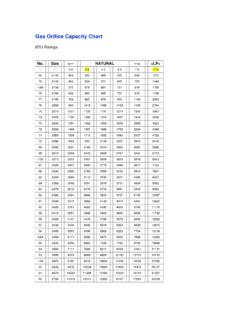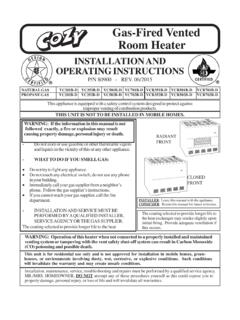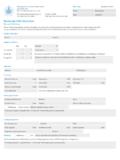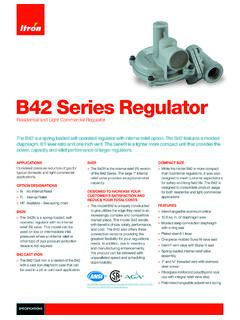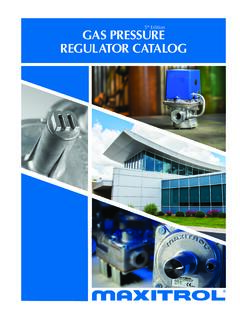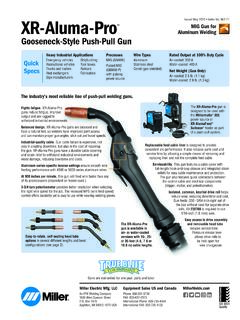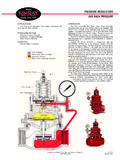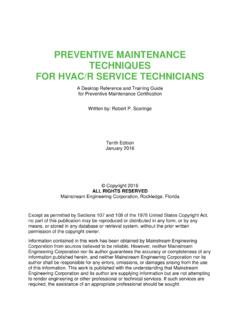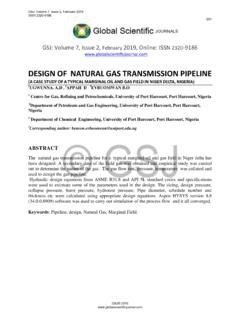Transcription of LP-GAS SERVICE TECHNICIAN’S HANDBOOK - Bergquist, Inc
1 LP-GAS SERVICE technician SHANDBOOK1-800-537-7518b1 INTRODUCTIONThis SERVICE technician s HANDBOOK has been developed by Cavagna, Inc., as a quick reference guide to be used by propane technicians performing field installation, operation and maintenance HANDBOOK has been written in a very straightforward and easy to understand format, with simple tables, diagrams and pictures to help guide SERVICE technicians through the process of installing and maintaining a propane gas system. While the HANDBOOK provides useful and key information, SERVICE technicians should also consult their company s policies and procedures; applicable federal, state and local laws; and industry rules and regulations, including the National Fire Protection Association (NFPA) pamphlets 54 and 58. Additional detailed information regarding regulator descriptions, specifications, installation, maintenance and repair are provided with the instruction manuals for each regulator OF CONTENTS ASME TANKS.
2 3 DOT CYLINDERS ..4 PROPANE GAS PROPERTIES ..5 DETERMINING TOTAL LOAD ..6 PROPANE VAPOR PRESSURE ..7 VAPORIZATION RATES ASME Tanks ..8 DOT Cylinders ..9 PURGING PROPANE GAS CONTAINERS Purging Water ..10 Purging Air ..11 CONTAINER LOCATION AND INSTALLATION DOT Cylinders ..12 Aboveground ASME Tanks ..13 Underground ASME Tanks ..14 CYLINDER MANIFOLDING ..15 PIPE AND TUBING SIZING ..16 Sizing Between First and Second Stage Table A - Copper Tubing ..18 Table B - Copper Tubing Type K ..19 Table C - Schedule 40 Black Iron ..20 Table D - Polyethylene (CTS) ..21 Table E - Polyethylene (IPS) ..22 Table F - CSST ..23 Sizing Between Second Stage Regulator and Appliance ..24 Table G - Copper Tubing Type K ..27 Table H - Copper Refrigeration Tubing ..2823 ASME TANKSASME tanks are used for both aboveground and underground propane SERVICE .
3 While they both serve the same purpose, there are some distinct differences which must be observed when being installed. Refer to the sections on Location and Installation on Pages 13 and 14. ASME tanks also come in many different sizes. Domestic installations usually range from 120 gallons to 1,000 ASME tanks have the same seven common appurtenances as listed below: Fill Valve - Connects the hose from delivery truck to the tank for re-fuelingRelief Valve - Vents propane in an over-pressure situationService Valve - Opening that is connected to the regulator and gas line to provide propane vapor to the appliancesFixed Liquid Level Gauge - Shows the level of propane is at or above 80% capacityFloat Gauge - Shows propane volume in the tank. Also called a dial gaugeVapor Return Valve - Connection used during propane delivery to remove excess tank pressureLiquid Withdrawal Valve - Used to withdraw liquid propane from the tankTABLE OF CONTENTS (Continued)REGULATORS.
4 34 First-Stage ..36 Second-Stage ..37 Integral Two Stage ..38 2 PSI ..39 Automatic Changeover ..40 Line/Appliance ..41 Installation ..43 LEAK TESTING ..46 TROUBLESHOOTING ..48 Table I - LP-GAS Orifice Capacities ..50 Table J - Line Sizing K - Conversion Factors ..52 Table L - Conversion Factors ..53 Table M - Flow N - Temperature Conversion ..5445 DOT CYLINDERSDOT Cylinders are used in a wide variety of both residential and commercial applications. As noted below, there are four different classes of DOT are five common appurtenances utilized with DOT cylinders. However, not all the appurtenances are found on each of the cylinders. Relief Valve - Vents propane in an over-pressure situationService Valve - Opening that is connected to the regulator and gas line to provide propane vapor to the appliancesFixed Liquid Level Gauge - Shows the level of propane is at or above 80% capacityFloat Gauge - Shows propane volume in the tank.
5 Also called a dial gaugeFill Valve - Connects the hose from the fill source to the cylinder for refilling PORTABLE MOTOR FUEL EXCHANGE STATIONARYPROPANE GAS PROPERTIESP ropane Gas Properties are the characteristics, qualities and combustion data of propane table below lists the important properties for SERVICE Technicians to PROPERTIES OF PROPANE GASF ormulaC3H8 Initial Boiling Point, F-44 Specific Gravity of Liquid(Water = ) at 60 per Gallon of Liquid at60 F, Heat of Liquid, BTU/LB at 60 feet of Vapor perGallon at 60 feet of Vapor perPound at 60 Gravity of Vapor(Air = ) at 60 Temperature in Air, F920 - 1,120 Maximum Flame Temperature in Air, F3,595 Cubic feet of Air Required toBurn One Cubic Foot of of Flammability in Air,% of Vapor in Air-Gas Mix: (a) Lower(b) Heat of Vaporization atBoiling Point:(a) BTU per Pound(b) BTU per Gallon184773 Total Heating Values AfterVaporization:(a) BTU per Cubic Foot(b) BTU per Pound(c) BTU per Gallon2,48821,54891,50267 DETERMINING TOTAL LOADD etermining Total Load is the sum of all propane gas used in an installation and is expressed in Btu s (British Thermal Units).
6 Determining the Total Load is necessary for sizing the tank or cylinders, regulators and piping for an installation. This is done by adding the Btu input of all appliances being used. The Btu information can be found on the nameplate of the appliance, or in the manufacturer s properly determine total load, it s also important to ask the customer about any future appliances which may be added at a later date. By adding in those Btu s now, later revisions in the container and piping can be table below shows the approximate Btu input required for common gas Required for Common AppliancesAPPLIANCEAPPROX. INPUT BTU/HRWarm Air Furnace Single Family Multifamily, per unit100,00060,000 Hydronic Boiler, Space Heating Single Family Multifamily, per unit100,00060,000 Hydronic Boiler, Space & Water Heating Single Family Multifamily, per unit120,00075,000 Range, Free Standing, DomesticBuilt-In Oven or Broiler Unit, DomesticBuilt-In Top Unit, Domestic65,00025,00040,000 Water Heater, Automatic Storage, 30 to 40 gal.
7 TankWater Heater, Automatic Storage, 50 gal. TankWater Heater, On-Demand2 gal. per minute capacity 4 gal. per minute6 gal. per minuteWater Heater, Domestic, Circulating or Side-Arm35,00050,000142,800285,000428,00 035,000 RefrigeratorClothes Dryer, Type 1 (Domestic)Gas Fireplace direct ventGas logBarbecueGas LightIncinerator, Domestic3,00035,00040,00080,00040,0002,5 0035,000{PROPANE VAPOR PRESSUREV apor Pressure is what forces propane gas from the through the piping the appliance. Because the amount of pressure inside a container depends on the outside temperature of the air, lower temperatures mean less pressure and higher temperatures mean more pressure. If the container pressure is too low, not enough gas will flow from the container to the appliances. Container pressure is measured in PSIG (Pounds Per Square Inch Gauge).The table below shows propane vapor pressures at various outside Pressures of LP-GasesTemperature( F)Propane Approximate Pressure (PSIG)-40 -30 -20 -10 RATES FOR ASME TANKS and DOT CYLINDERSV aporization is the rate at which liquid propane boils off and becomes vapor.}
8 The larger the wetted surface of the container (that area of the container filled by liquid propane), the faster the liquid boils off into vapor. Therefore, the vaporization rate of a container is dependent upon the temperature of the liquid and the amount of wetted surface of the determining the proper size container to handle an installations total load, the lowest winter temperature must be taken into is important to know that because of the various shapes of containers, the wetted surface area will be different and therefore, the vaporization rates will be different. The table below assumes the ASME tank is one-half full, the relative humidity is 70% and the tank is under intermittent draw. It shows the intermittent withdrawal (Btu/hr) vaporization rate outside temperature in degrees Fahrenheit and the vapor pressure in pounds per square inch at various temperatures. ASME TankTEMPERATURETANK SIZE (GALLONS)1502505001,00040 F214,900288,100478,800852,80030 F187,900251,800418,600745,60020 F161,800216,800360,400641,90010 F148,000198,400329,700587,2000 F134,700180,600300,100534,500-10 F132,400177,400294,800525,400-20 F108,800145,800242,300431,600-30 F107,100143,500238,600425,000 VAPORIZATION RATES FOR ASME TANKS and DOT CYLINDERS(Continued)This second table assumes a DOT 100 pound cylinder under maximum continuous draw.
9 Various temperatures and amounts of propane in the cylinder are shown. DOT 100 Pound CylinderLbs. of Propane In Continuous Draw in BTU Per Hour AtVarious Temperatures in Degrees F20 F40 F60 F70 F100113,000167,000214,000277,000300,0009 0104,000152,000200,000247,000277,0008094 ,000137,000180,000214,000236,0007083,000 122,000160,000199,000214,0006075,000109, 000140,000176,000192,0005064,00094,00012 5,000154,000167,0004055,00079,000105,000 131,000141,0003045,00066,00085,000107,00 0118,0002036,00051,00068,00083,00092,000 1028,00038,00049,00060,00066,0001011 PURGING PROPANE GAS CONTAINERSP urging Propane Gas Containers is the removal of water and air from the containers prior to installation and filling at a customer s site or at the bulk and air in a propane container will seriously contaminate and interfere with an entire propane system, resulting in improper operation of not only the system, but also the customer s appliances.
10 Improper operation will result in costly SERVICE calls and needless extra expense. Both ASME and DOT specifications require water and air be purged from all containers before being placed in SERVICE . Further, the procedure MUST always be performed at the bulk plant and NEVER at the customer s WaterEven though the inside of a container may appear to have no visible moisture present, condensation may have formed on the interior walls, plus the air inside the container may have a relative humidity up to 100%. To neutralize this moisture, use Anhydrous Methanol in amounts according to the chart below. Note the Anhydrous Methanol must be pure. Under NO circumstances should any substitute products be TypeMinimum VolumeMethanol Required100 lb. ICC cylinder420 lb. ICC cylinder500 gal. tank1000 gal. tank1/8 pt. (2 fl. ozs.)1/2 pt. (8 fl. ozs.)5 pts. (21/2 qts.)10 pts. (11/4 gal.)PURGING PROPANE GAS CONTAINERS (Continued)Purging AirThere is a natural volume of air in all propane containers that must be removed before the first fill.


